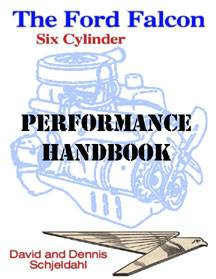Yes for the 1966 year models and most of the rest of Ford 200 and 250 Six engine production to about the end of the 1979 they were no longer color keyed to the specific engine models, all Ford engines were now painted a Ford Corporate Dark Blue. This was the new color for all Ford engines for 1966 and later. As with before the entire Engine long block was painted after it was assembled only the the valve covers were painted separate and than installed on the engine with the natural finish metal bolts with the special integral lock washers same as the earlier engines. The exception to using this Dark Ford Corporate Blue color were on the last of the 200 & 250 six engine production for the 1980 to 1983 models, to add some further confusion many auto parts companies market 3 different Ford Blue colors.
In 1966 to 1972 the 170 six'es were also still being used they were the base engines in the Falcons, Comet's, and the new debut in 1969 1/2 of the "1970" Maverick's. They are also painted the same Dark Ford Corporate Blue as the 200's and 250's see below for example. The picture is of a 1966 200 engine these later model 200's had air cleaners that were made a little different from the early 1963 1/2 to 1965 engines. The Sports Sprint models had a chrome air-cleaner housing, as did the 1966 Mustang Sprint 200, made available during Spring 1966.
1966 up Falcon, Fairlane, Maverick, Comets, and 1966 to 1973 Mustang 200 six Engine Color Reference
Engine/Part Color
200ci valve cover Dark Ford Corporate Blue Duplicolor's DE 1606 Dark Ford Blue or Plastickote # 224
200ci air cleaner Dark Ford Corporate Blue Duplicolor's DE 1606
200ci block, head, oil pan Dark Ford Corporate Blue Duplicolor's DE 1606
1966 Ford 200 Six

Fords small sixes from 1966 up to 1972 for the 170 Six's, the 1966 to 1979 200 Six's, and 1969 to 1979 250 Six'es used in the Falcon, Fairlane, Maverick, Comet, Granada, Monarch, " the 250 six in the 1969 to 1973 Mustang's" were also painted that same Dark Ford Corporate Blue. For the 1966 up color of Ford Corporate (Dark) Blue, Duplicolor's 1606 matches this. Some other brands that also match the Ford Blue are Krylon's Ford Dark Blue and Plasticoat Royal Blue 1134. For the accessory parts like pulleys, fans, starters, alternator brackets & belt adjusters, etc. these were all painted Semi Gloss Black a good match is Duplicolor's 1635. Good luck on your restoration.





